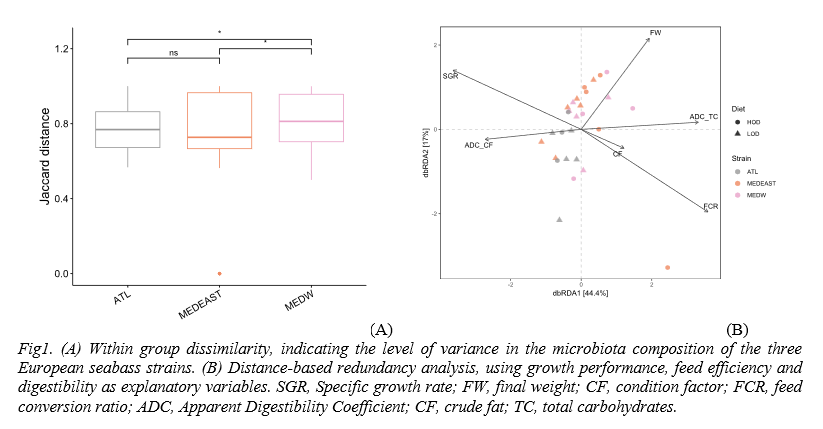EXPLORING DIET × STRAIN INTERACTIONS ON THE GUT MICROBIAL STRUCTURE OF EUROPEAN SEABASS: A LONG-READ SEQUENCING APPROACH
Introduction
Feed is considered as one of the major factors for sustainable aquaculture development in the world , and its composition directly influences feed intake and efficiency of fed aquatic animal production . At the same time, the dietary composition of the aquafeeds can have a direct impact on the gut microbiota modulation, ultimately affecting host growth and health (Butt & Volkoff, 2019). Besides the diet, v arious factors, such as host genetics, age and environmental conditions, are also known to have an influence on the gut microbiota of aquatic species (Mougin & Joyce, 2023). Especially the role of genetics on the microbiota composition of aquaculture fish has been less explored, but few studies have shown that host genotype variability can also alter the microbiota composition (Kokou et al., 2018 ; Piazzon et al., 2020). At the same time, the host genotype or strain can affect the nutritional utilization of the diet and fish growth rates (Li et al., 2019 ). Whether differences in the feed utilization between different fish strains link to differences in the gut microbiota composition, remains largely unexplored . In the present study, we explored this research question, by testing three strains of European seabass, fed with two diets, differing in macronutrient composition. Moreover, we utilized a long-read sequencing approach targeting the full-length 16S ribosomal gene for the first time in European seabass, in order to evaluate its applicability in characterizing its mucosal microbial communities under different experimental conditions.
Materials & Methods
A 10-week feeding trial was performed, evaluating two diets with different macronutrient composition: a diet with high carbohydrate content (HOD), and a diet with high fat content (LOD). The diets were formulated to have a similar dietary protein/dietary energy ratio (DP/DE ; ~19 kJ/g dry matter). Three strains of European seabass ( average weight 67.8g ± 0.58), originating from IFREMER ( Palavas-les-Flots, France) were stocked in separate tanks; an Atlantic strain (ATL), an East Mediterranean strain (MEDEAST) and a West Mediterranean strain (MEDW). The fish were fed twice daily (09.00 and 15.00) u p to satiation level. At the end of the five- week period, the diets were switched, and the feeding resumed for five more weeks. Gut mucosal samples were taken for microbiota analysis at week 5 and week 10 from 3 fish per tank . Prior to characterizing the microbial communities of the gut samples, we performed a comparative analysis using both Illumina and Oxford long-read sequencing, targeting the 16S rRNA gene, to understand whether profiling o f gut microbial communities is affected by the sequencing platform, and in order to optimize the sequencing conditions . After DNA extraction, gut mucosal samples were sequenced using our optimized protocol for Oxford Nanopore targeting the full-length 16S. Diversity and microbial composition analysis, along with statistical analysis were performed using the microeco R package.
Results & Discussion
Comparison of different sample types using Illumina MiSeq targeting the V3-V4 region, and long-read sequencing using Oxford Nanopore targeting the full-legth of the 16S rRNA gene, showed some differences in the microbial profiling, especially with relation to the abundance of Proteobacteria and Firmicutes phyla. This has been also previously reported in gilthead seabream microbiota, when performing a similar comparison (Toxqui-Rodríguez et al., 2023). However, when testing whether these differences are affecting the sensitivity of our platform, no significant effects were observed, suggesting that Oxford Nanopore can be used for the characterization of mucosal microbiota.
When comparing the mucosal samples coming from different diets, m icrobial alpha diversity did not show any significant differences (P > 0.05); however, an effect of the strain was found to affect gut microbial structure. Interestingly, we found a higher dissimilarity with in the gut microbiota composition of the West Mediterranean strain compared to that of the Atlantic and East Mediterranean strain . Specifically, we found a lower individual variability within the Atlantic strain (Fig1A), which could indicate a more homogenous genetic structure of this stra in, making the microbiota of those individuals more similar to each other.
In a similar fashion, a clear separation of Atlantic strain was observed when correlating the structure of microbiota data with growth and digestibility parameters by the distance-based redundancy analysis (dbRDA; Fig1B ). The dbRDA plot also may indicate a different capacity of the Atlantic strain in the utilization of different diets . These could be potentially explained by a different coping capacity with dietary changes , and particularly carbohydrate digestion. Similar observations in genetically selected fish were reported by Torecillas et al. (2023), demonstrating capacity to reshape their microbiota to better adapt to the diet .
To conclude, diet did not cause any clear patterns in the gut microbiota diversity of E uropean seabass. However, we observed an effect of the fish strain on the gut microbiota structure and variability, which correlated to different growth rates in the Atlantic strain.
References
Butt R. L. & Volkoff H. (2019). Gut microbiota and energy homeostasis in fish. Frontiers in Endocrinology, 10, 9.
Kokou F. et al. (2018). Host genetic selection for cold tolerance shapes microbiome composition and modulates its response to temperature. Elife, 7, e36398.
Li H. et al. 2019. Effects of dietary carbohydrate and lipid concentrations on growth performance, feed utilization, glucose, and lipid metabolism in two strains of gibel carp. Frontiers in veterinary science, 6, p.165.
Mougin J. & Joyce, A. (2023). Fish disease prevention via microbial dysbiosis‐associated biomarkers in aquaculture. Reviews in Aquaculture, 15(2), 579–594.
Piazzon M. C. et al. (2020). Genetic selection for growth drives differences in intestinal microbiota composition and parasite disease resistance in gilthead sea bream. Microbiome, 8, 1–17.
Torrecillas S. et al. (2023). Genotype x nutrition interactions in European sea bass (Dicentrarchus labrax): Effects on gut health and intestinal microbiota. Aquaculture, 574, 739639.
Toxqui-Rodríguez et al. (2023) "Fish microbiomics: Strengths and limitations of MinION sequencing of gilthead sea bream (Sparus aurata) intestinal microbiota." Aquaculture 569 (2023): 739388.
